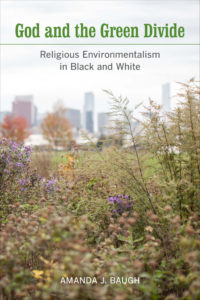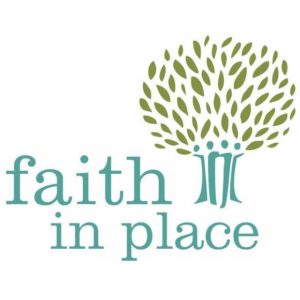Protestant Assumptions and the “Green Ceiling”
An excerpt from the book God and the Green Divide: Religious Environmentalism in Black and White
The following excerpt comes from Amanda Baugh’s God and the Green Divide: Religious Environmentalism in Black and White (University of California Press). The book explores issues of race within American religious environmental activism.
This excerpt comes from the book’s introduction.
***
 “The State of Diversity in Environmental Organizations,” a 2014 study of more than three hundred environmental groups in the United States, concluded that the state of racial diversity among those organizations was “troubling,” with ethnic minorities constituting a scant 12 percent of leadership positions and 16 percent of board members and general staff. While the study found the organizations had made significant progress on diversity in terms of gender, most of the gains went to white women, and men were still significantly more likely to hold the most powerful positions. In terms of membership and volunteers, the organizations remained “predominately white.” The report concluded that people of color had been unable to break the “green ceiling” that had barred minorities from leadership positions over the previous fifty years, despite the fact that minority communities demonstrated greater support for environmental protection than whites.
“The State of Diversity in Environmental Organizations,” a 2014 study of more than three hundred environmental groups in the United States, concluded that the state of racial diversity among those organizations was “troubling,” with ethnic minorities constituting a scant 12 percent of leadership positions and 16 percent of board members and general staff. While the study found the organizations had made significant progress on diversity in terms of gender, most of the gains went to white women, and men were still significantly more likely to hold the most powerful positions. In terms of membership and volunteers, the organizations remained “predominately white.” The report concluded that people of color had been unable to break the “green ceiling” that had barred minorities from leadership positions over the previous fifty years, despite the fact that minority communities demonstrated greater support for environmental protection than whites.
Developing initiatives to chip away at the “green ceiling” was a central goal at Faith in Place. A report the organization’s leaders submitted to the nonprofit reporting service GuideStar stated that their long-term success would be measured by the degree to which environmental activities became mainstream among faith communities and “the degree to which our efforts bring new voices and new faces (especially those of people of color) into the overall environmental movement.” The weatherization project featured in this introduction’s opening was specifically designed to contribute to that goal by involving African Americans in the work of Faith in Place. As coordinator of African American outreach, Kyle developed new tactics and programs intended to meet the needs of African Americans while simultaneously advancing the goals of Faith in Place. To that end, she developed the weatherization project to promote environmental literacy, provide immediate (albeit short-term) employment, and offer experiences that would lead to greater opportunities in the future. Kyle fundamentally changed the work and demographics of Faith in Place, seeming to overcome challenges of diversification that environmental leaders had struggled with for five decades. In this book I set out to understand how that happened.
I do not anticipate that readers will disagree with my contention about the importance of race, ethnicity, and class in our understandings of religious environmentalism. The dearth of people of color in the mainstream environmental movement is an important issue that has been discussed by scholars and activists alike. It is clear that a more effective and equitable form of environmentalism must include the perspectives of communities diverse in terms of race, ethnicity, and class, and my research at Faith in Place contributes to understanding some of those diverse perspectives.
 But Faith in Place enacted a different kind of power dynamic that was not included in the “Green Ceiling” report or in studies of environmental or religious environmental organizations more broadly. Ironically, that dynamic had to do with religion. Faith in Place’s work, and interfaith environmentalism more broadly, entailed certain assumptions about the role and place of religion in the modern world, the nature of humans’ relationship with the divine, and explanations of cause and effect. These assumptions have been shaped by a secularized liberal Protestant culture, whether those who hold those viewpoints identify as Protestants or not. Faith in Place offered a distinctively modern, progressive Protestant way of being religious. Its leaders unknowingly enforced boundaries that designated “good” religion, while excluding religious beliefs and behaviors that did not adhere to their liberal Protestant norms. I provide examples of these distinctions in chapters 5 and 6.
But Faith in Place enacted a different kind of power dynamic that was not included in the “Green Ceiling” report or in studies of environmental or religious environmental organizations more broadly. Ironically, that dynamic had to do with religion. Faith in Place’s work, and interfaith environmentalism more broadly, entailed certain assumptions about the role and place of religion in the modern world, the nature of humans’ relationship with the divine, and explanations of cause and effect. These assumptions have been shaped by a secularized liberal Protestant culture, whether those who hold those viewpoints identify as Protestants or not. Faith in Place offered a distinctively modern, progressive Protestant way of being religious. Its leaders unknowingly enforced boundaries that designated “good” religion, while excluding religious beliefs and behaviors that did not adhere to their liberal Protestant norms. I provide examples of these distinctions in chapters 5 and 6.
Liberal Protestant domination within religious environmentalism has manifested at two levels, one very concrete and the other less quantifiable but nevertheless quite real. First, mainline Protestants have dominated the leadership positions of interfaith environmental organizations in the United States. IPL, the umbrella organization hosting state chapters in forty states, was founded by an Episcopal priest. Green Faith’s founding director was Episcopal as well. State IPL chapters recruited Jews, Muslims, Catholics, and other religious minority groups to their steering committees and boards of directors, but mainline Protestants filled nearly two-thirds of those positions in 2015. Among the forty-four staff members who provided their religious affiliations on their state IPL’s websites in the same year, thirty-six, or 82 percent, were mainline Protestants. While purporting to represent the viewpoints of every faith, interfaith environmental coalitions in the United States were shaped strongly by mainline Protestants.
Second, whether liberal Protestants or not, those involved with religious environmental projects in the United States tend to maintain progressive religious values and secular understandings of the world. In the past several decades, scholars have identified ways that Protestant understandings of the world—understandings of relations between the human and divine, the natural and the supernatural, that developed from Enlightenment thought and contributed to the Protestant Reformation—have shaped what we now identify as secularism. Rejecting the notion that the secular is merely the absence of religion, scholars now assert that secularism itself is a religious project and offers a particular way of being religious. Secular moderns inhabit what philosopher and political theorist Charles Taylor calls the “immanent frame,” a worldview in which cause-and-effect relationships are assumed to be this-worldly, rather than resulting from actions of the divine. Taylor contends that this secular way of understanding the world is a defining feature of modernity, and he joins scholars such as anthropologist Talal Asad as he disputes the supposedly clear distinction between the religious and the secular. The religious and the secular are always defined in relation to each other, these scholars point out, and in the context of the West ideas of the secular are informed by liberal Protestant Christianity. A defining characteristic of what we might call secular religion is that its assumptions are taken for granted, so leaders at Faith in Place would not recognize the ways in which their organization enforced particular ideas about what counts as “good” religion. The religious power and authority they assert, in other words, are unmarked.
The women and men I met at Faith in Place brought to the organization modern religious worldviews in which they understood their actions within the immanent frame. In other settings they may have expressed belief in a transcendent God. But at Faith in Place they learned to deal with the global water crisis by incorporating native plants and permeable surfaces outside their churches, not by praying to God for relief. They learned to address food injustices by building community gardens, not by looking forward to a better world with the coming of the Kingdom of God. And they learned to curb climate change through policy advocacy, not petitionary prayer. These steps may seem like perfectly reasonable actions to take in light of modern, secular understandings of the world, and as such they seem like logical measures to prescribe to Faith in Place’s intended audience: all people of faith. Yet as scholars such as Taylor and Asad insist, modern secular assumptions are shaped in relationship to particular religious views, and in the Western context inhabited by Faith in Place those particular religious views rely heavily on liberal Protestant thought.
Faith in Place offered one way of being religious, a way that conformed to the dictates of liberal modernity. It offered a “welcoming space” for adherents of what was deemed “good” religion and excluded others by not recognizing their beliefs and practices as properly religious. Religious viewpoints that entailed belief in a supernatural God and allowed for the possibility of God’s intervention in human history were not especially welcome at Faith in Place, where the Unitarian Universalist executive director’s theological outlook was grounded in a rejection of the supernatural. The organization claimed to represent people from “every faith,” but it did not involve representatives of different faiths whose religious outlooks acknowledged the existence of a “transcendent frame,” a contradiction I examine in chapter 6. Just as it is important to underline ways that constructions of religious environmentalism are always racially marked, it is important to notice how constructions of religious environmentalism are shaped by particular religious understandings. I set out to understand those assumptions and the ways they shaped Faith in Place’s religious environmental activism, in the following pages.
Amanda J. Baugh is an Associate Professor of Religious Studies at California State University, Northridge. She is the author of God and the Green Divide: Religious Environmentalism in Black and White.